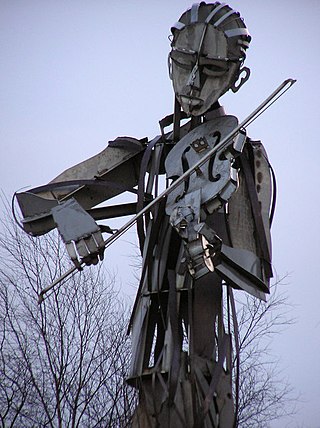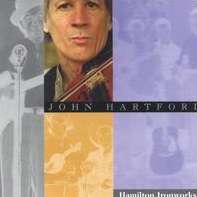
The Donegal fiddle tradition is one of the distinct fiddle traditions within Irish traditional music. The distinctness of the Donegal tradition developed due to the close relations between County Donegal and Scotland, and the Donegal repertoire and style has influences from Scottish fiddle music. For example, in addition to the ”universally known” standard Irish dance tunes, there is an added volume of Scottish and Nova Scotia tunes played, with even some tunes from Shetland and Orkney. This includes standard tune types such as double jigs, slip jigs, reels, and hornpipes. It has been claimed that Donegal musicians play more slip jigs than any other region of Ireland. This is potentially due to the geographical borders/mountains keeping Donegal's repertoire more locally-known for decades. There is also a prevalence of mazurka playing. Mazurkas are historically mainland-European tunes very similar to a waltz, in its 3
4 meter, though generally livelier and with more emphasis being placed on the second beat of each measure. Another uniquely Donegal tune is called the barndance, stemming from the Germanic schottische, also similar to the Norwegian reinlander. The barndance is very similar to a hornpipe, but slower than a reel; typically they are played with less of a hornpipe's “swing” and more of the “drive” of a reel.

A fiddle is a bowed string musical instrument, most often a violin. It is a colloquial term for the violin, used by players in all genres, including classical music. Although in many cases violins and fiddles are essentially synonymous, the style of the music played may determine specific construction differences between fiddles and classical violins. For example, fiddles may optionally be set up with a bridge with a flatter arch to reduce the range of bow-arm motion needed for techniques such as the double shuffle, a form of bariolage involving rapid alternation between pairs of adjacent strings. To produce a "brighter" tone than the deep tones of gut or synthetic core strings, fiddlers often use steel strings. The fiddle is part of many traditional (folk) styles, which are typically aural traditions—taught "by ear" rather than via written music.

The Ozarks, also known as the Ozark Mountains, Ozark Highlands or Ozark Plateau, is a physiographic region in the U.S. states of Missouri, Arkansas, and Oklahoma, as well as a small area in the southeastern corner of Kansas. The Ozarks cover a significant portion of northern Arkansas and most of the southern half of Missouri, extending from Interstate 40 in central Arkansas to Interstate 70 in central Missouri.

Old-time music is a genre of North American folk music. It developed along with various North American folk dances, such as square dancing, contra dance, clogging, and buck dancing. It is played on acoustic instruments, generally centering on a combination of fiddle and plucked string instruments, most often the banjo, guitar, and mandolin. Together, they form an ensemble called the string band, which along with the simple banjo-fiddle duet have historically been the most common configurations to play old-time music. The genre is considered a precursor to modern country music.
Melvin Wine was an American Appalachian fiddler from the state of West Virginia. He was a lifelong resident of Copen, in Braxton County, West Virginia.

The fiddle is one of the most important instruments in the traditional repertoire of Irish traditional music. The fiddle itself is identical to the violin, however it is played differently in widely varying regional styles. In the era of sound recording some regional styles have been transmitted more widely while others have become more uncommon.
Scottish fiddling may be distinguished from other folk fiddling styles by its particular precision of execution and energy in the delivery, for example, the rendering of the dotted-quaver/semi-quaver rhythmic patterns, commonly used in the Strathspey. Christine Martin, in her Traditional Scottish Fiddling players guide, discusses the techniques of "hack bowing", "the Scotch snap", and "snap bowing". These techniques contrast quite sharply with the most common bowing patterns of Irish fiddling. The style has a very large repertoire consisting of a great variation of rhythms and key signatures. There is also a strong link to the playing of traditional Scottish bagpipes which is better known throughout the world.

Brad Leftwich is an American old-time fiddler, banjo player, singer and teacher of traditional old-time style. He is originally from Oklahoma but has resided in Bloomington, Indiana for most of his life. He performs solo and with his long-time musical partner and wife, Linda Higginbotham, and with his band, The Humdingers, which also includes Sam Bartlett and Abby Ladin.

Hamilton Ironworks is John Hartford's last album, recorded before his death in 2001. Along with the Hartford Stringband, Hartford interprets 22 traditional fiddle tunes. The title track is a traditional Ozarks tune referring to an old mine in Meramec State Park, Missouri.
Bob Holt was an American fiddler, playing old-time and for square dances. He was known for his lightning-fast, energetic style of playing. He played his signature song "Ninth of January" at as much as 144 beats per minute while playing for dances. He was born on November 25, 1930, in Ava, Douglas County, Missouri. He died March 19, 2004, in Ava.

American fiddle-playing began with the early European settlers, who found that the small viol family of instruments were more portable and rugged than other instruments of the period. According to Ron Yule, "John Utie, a 1620 immigrant, settled in the North and is credited as being the first known fiddler on American soil". Early influences were Irish, Scottish, and English fiddle styles, as well as the more upper-class traditions of classical violin playing. Popular tunes included "Soldier's Joy", for which Robert Burns wrote lyrics, and other tunes such as "Flowers of Edinburgh" and "Tamlin," which have both been claimed by both Scottish and Irish lineages.

Old timefiddle is the style of American fiddling found in old-time music. Old time fiddle tunes are derived from European folk dance forms such as the jig, reel, breakdown, schottische, waltz, two-step, and polka. When the fiddle is accompanied by banjo, guitar, mandolin, or other string instruments, the configuration is called a string band. The types of tunes found in old-time fiddling are called "fiddle tunes", even when played by instruments other than a fiddle.
"Blues fiddle" is a generic term for bowed, stringed instruments played on the arm or shoulder that are used to play blues music. Since no blues artists played violas, the term is synonymous with violin, and blues players referred to their instruments as "fiddle" and "violin".

Canadian fiddle is the aggregate body of tunes, styles and musicians engaging the traditional folk music of Canada on the fiddle. It is an integral extension of the Anglo-Celtic and Québécois French folk music tradition but has distinct features found only in the Western hemisphere.
Métis fiddle is the style that the Métis of Canada and Métis in the northern United States have developed to play the violin, solo and in folk ensembles. It is marked by the percussive use of the bow and percussive accompaniment. The Métis people are a poly-ethnic post-contact Indigenous peoples. Fiddles were "introduced in this area by Scottish and French-Canadian fur traders in the early 1800s", where the Metis community adopted the instrument into their culture.
Athabaskan fiddle is the old-time fiddle style that the Alaskan Athabaskans of the Interior Alaska have developed to play the fiddle (violin), solo and in folk ensembles. Fiddles were introduced in this area by Scottish, Irish, French Canadian, and Métis fur traders of the Hudson's Bay Company in the mid-19th century. Athabaskan fiddling is a variant of fiddling of the American southlands. Athabaskan fiddle music is most popular genre in Alaska and northwest Canada and featuring Gwich'in Bill Stevens and Trimble Gilbert.
Randy Howard (1960–1999) was an American bluegrass, country and old time fiddler.
Lonnie Robertson was an American musician, singer and composer
Vivian Williams was an American fiddler, composer, recording artist, and writer. She won national fiddling titles, including the National Oldtime Fiddlers Contest, and in 2013 she was inducted into the North American Old Time Fiddlers Hall of Fame.

Howard Wight Marshall is an American academic, author, folklorist, historian, and fiddler. He is a professor emeritus and former chair of the Department of Art History and Archeology at the University of Missouri in Columbia, Missouri. In addition to his work on regional folk architecture he researches fiddling traditions in Missouri and the Ozarks, especially the style known as Missouri fiddling. Marshall is the founding director of the Missouri Cultural Heritage Center. In 2018 he received the Missouri Humanities Council Distinguished Literary Award.











